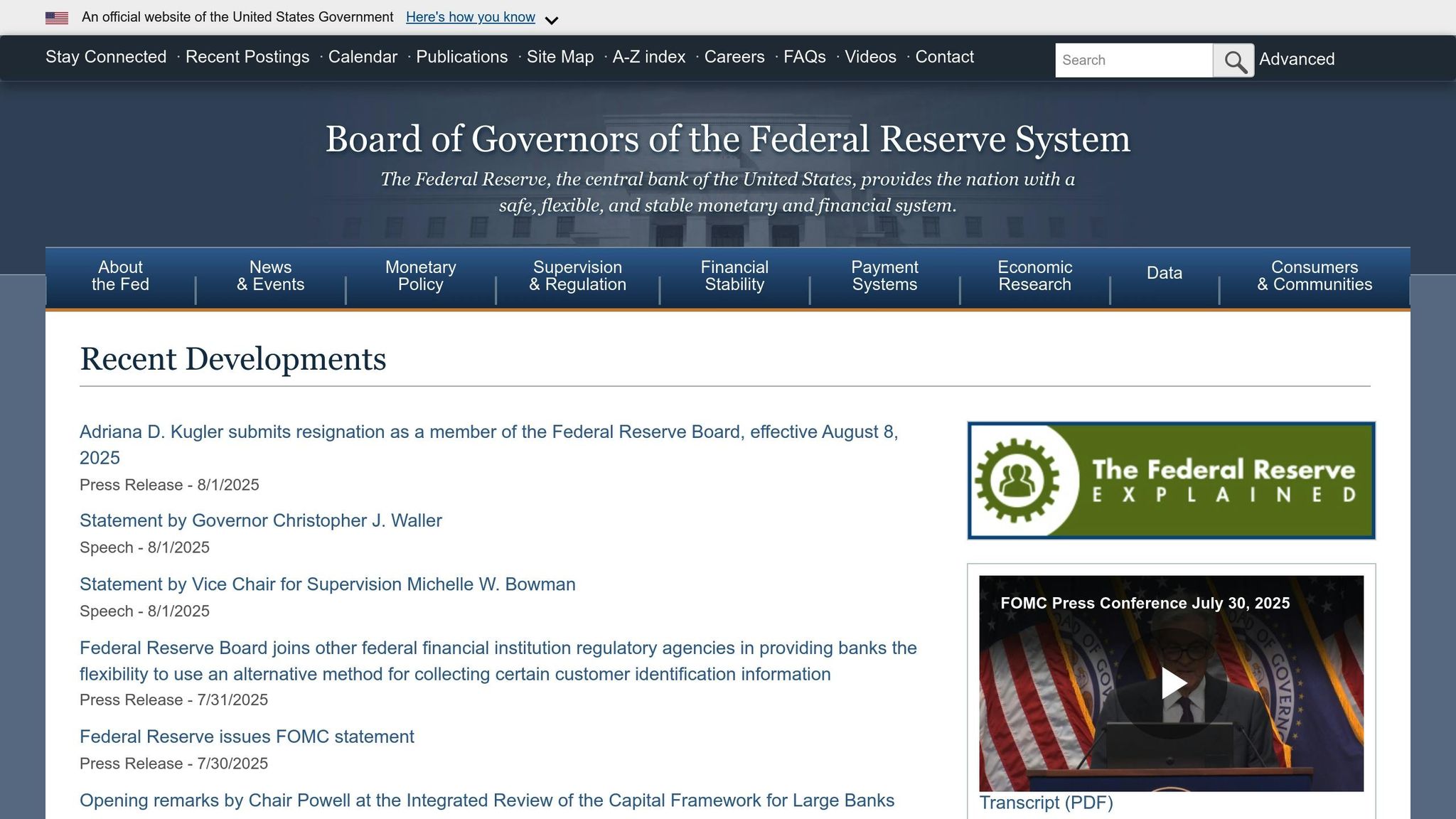The COVID-19 pandemic caused a severe liquidity crisis in the corporate bond market, exposing vulnerabilities in how debt portfolios are managed during economic shocks. Here's what happened:
This crisis highlighted the need for better liquidity management strategies and the growing importance of technology-driven trading platforms like Debexpert. These tools helped maintain trading activity and provided real-time analytics during periods of extreme volatility. The lessons learned emphasize the importance of preparing for future disruptions in the $34 trillion corporate bond market.
In March 2020, the corporate bond market faced a severe liquidity crisis as the COVID-19 pandemic disrupted what had been a relatively stable environment. Investors scrambled to offload positions, driven by growing fears about the pandemic's economic fallout. This sudden shift created chaos, with trading costs soaring and dealers struggling to manage the market's demands.
Transaction costs skyrocketed during this period, reaching over 90 basis points before the Federal Reserve stepped in - an increase of 200% compared to early February levels.
Large trades were hit the hardest. Costs for block trades in investment-grade bonds surged from 24 basis points in February to over 150 basis points by March 23. This marked a six-fold increase in just a few weeks. Even more unusual, the typical pricing advantage for larger trades disappeared. Where block trades had previously been about 10 basis points cheaper than smaller trades, they suddenly became over 60 basis points more expensive. This pricing flip highlighted the strain dealers were under, as they struggled to execute large trades without inflating costs.
Securities dealers, who play a crucial role in facilitating bond market transactions, added to the market's challenges. As conditions worsened, dealers became increasingly hesitant to hold corporate bonds on their balance sheets. Non-primary dealers, in particular, shifted from buying bonds to selling them, further reducing liquidity. Rising repo costs and balance sheet limitations only deepened these issues, leaving the market in a precarious state.
The crisis also triggered a noticeable shift in trading patterns. Customer-to-customer trade volumes nearly tripled compared to pre-crisis levels. However, this came at a price: transaction costs in these trades more than doubled those of customer-to-dealer trades. Meanwhile, institutional prime money market funds saw their total assets under management drop by roughly 30% in just two weeks, and fixed-income funds experienced an unprecedented 12% outflow in a single month. Funds holding less liquid bonds or those tied to industries hardest hit by the pandemic were particularly affected.
The Federal Reserve later summarized the chaos of this period:
During the two weeks leading up to Federal Reserve System interventions, volume shifted to liquid securities, transaction costs soared, trade-size pricing inverted, and dealers, particularly non-primary dealers, shifted from buying to selling, causing dealers' inventories to plummet.
These stark liquidity metrics underscored the urgency of the Federal Reserve's subsequent interventions, which laid the groundwork for the market's recovery - a topic explored in the next section.

The Federal Reserve acted swiftly to address the corporate bond market turmoil, implementing measures that surpassed the scale of its 2008 crisis response. These efforts targeted both primary and secondary markets, providing direct support to corporate debt markets.
On March 23, 2020, the Federal Reserve introduced two key programs: the Primary Market Corporate Credit Facility (PMCCF) and the Secondary Market Corporate Credit Facility (SMCCF). Both programs were structured as special purpose vehicles, funded through Treasury equity stakes and Federal Reserve-held debt.
The PMCCF allowed the Fed to lend directly to corporations by purchasing newly issued bonds and offering loans. This initiative aimed to support businesses in maintaining operations during the pandemic by ensuring access to new debt. On the other hand, the SMCCF focused on stabilizing the secondary market by purchasing existing corporate bonds and exchange-traded funds (ETFs) that invest in investment-grade corporate bonds.
Initially, these programs were backed by $100 billion but were later expanded to support a combined $750 billion in corporate debt. The Treasury allocated $75 billion from its Exchange Stabilization Fund as a buffer against potential losses. The SMCCF included specific triggers, such as beginning ETF purchases when the corporate Baa-Treasury spread exceeded 300 basis points. These measures laid the groundwork for rapid market stabilization.
The announcement of the PMCCF and SMCCF on March 23, 2020, had an immediate impact, halting the rise in Baa-Treasury spreads. Within just a week of launching the facilities, bond transaction costs dropped from over 90 basis points to about 70 basis points.
The recovery gained momentum throughout April. By the month's end, transaction costs had fallen to approximately 40 basis points and remained stable. Investment-grade bonds saw immediate reductions in transaction costs following the interventions, while high-yield bonds experienced improvements only after the SMCCF was expanded.
The behavior of bond dealers also shifted significantly. Initially, dealers moved away from purchasing bonds, but after the Federal Reserve's actions, they resumed more active roles in market-making. Primary dealers, who had been hesitant to hold inventory during the crisis, began returning to normal trading patterns, transitioning from extreme customer-to-customer transactions back to standard customer-to-dealer flows.
"By improving dealer funding conditions and providing a liquidity backstop, the Primary Dealer Credit Facility and the Secondary Market Corporate Credit Facility (SMCCF) stabilized trading conditions".
These interventions not only reduced trading costs but also restored confidence in the market, offering critical lessons for managing debt portfolios during times of crisis.
The data below highlights the stark differences in market conditions before and after the Federal Reserve's interventions. Transaction costs, which had climbed from about 40 basis points on March 5 to nearly 90 basis points before the programs were announced, steadily improved following their launch.
| Metric | Pre-Intervention (March 5–23) | Post-Intervention (April–May) | Change |
|---|---|---|---|
| Average Transaction Costs | 40–90 basis points | 40 basis points | –50 to –56% improvement |
| Block Trade Costs (Investment Grade) | Over 150 basis points | Reduced | Major improvement |
| Customer-to-Customer Volume | Nearly tripled | Normalized | Returned to typical levels |
Interestingly, much of the SMCCF's impact came from its announcement alone rather than actual purchases. The PMCCF, despite being established, was never utilized. However, its presence alone was enough to bolster market confidence. By the time the SMCCF concluded, it had $14.1 billion in outstanding purchases, including over 1,300 bonds and bond ETFs. This was well below the program’s capacity but sufficient to restore market functionality.
During the crisis, transaction costs averaged 57 basis points higher than in normal times. Following the launch of the Primary Dealer Credit Facility, costs dropped by 24 basis points, though they remained above pre-crisis levels.
The Fed's intervention also proved financially beneficial. Remittances to the Treasury increased from $54.9 billion in 2019 to $88.5 billion in 2020. Additionally, the facilities created in response to COVID-19 generated $405 million in income. These outcomes showed that emergency measures could stabilize markets while remaining financially sound, offering valuable insights into managing liquidity risks effectively.
In early 2020, the corporate bond market faced significant liquidity challenges, as a combination of factors disrupted the market and prompted intervention by the Federal Reserve.
The pandemic introduced heightened credit and rollover risks, reshaping investor sentiment toward corporate bonds. Fixed-income funds experienced a staggering 12% outflow in just one month. The investment-grade bond market, which is about six times larger than the high-yield market, saw daily trading volumes of $22.1 billion compared to $7.8 billion in the high-yield market, intensifying the strain. Institutional prime money market funds faced a sharp decline, with total assets under management dropping by nearly 30% in just two weeks.
These massive outflows raised serious concerns about companies' ability to refinance existing debt while also casting doubt on their creditworthiness in an increasingly uncertain economic environment. Adding to these challenges, social distancing measures created operational hurdles that further stressed the market.
Operational disruptions caused by social distancing compounded the volatility in bond markets. Mandatory shutdowns and distancing measures introduced sector-specific risks that traditional credit models were ill-equipped to handle. Research revealed that companies more affected by social distancing saw their yield spreads widen by an average of 40.9 basis points compared to businesses better suited to remote operations. Sectors like hospitality, retail, and entertainment were hit especially hard, while technology and healthcare companies showed greater resilience.
A spike in financial market volatility, combined with concerns about markets' ability to function in a remote work environment, resulted in a surge in the demand for cash. - Lorie K. Logan, Executive Vice President, Federal Reserve Bank of New York
Firms in industries less adaptable to remote work were more likely to seek additional debt financing but faced higher borrowing costs compared to their peers. This dynamic added further pressure to an already strained market.
Traditional mechanisms that typically stabilize markets during periods of stress either failed or exacerbated liquidity challenges during COVID-19. For instance, customer-to-customer trading volume increased but often came with prohibitively high costs. When institutional investors found dealers unwilling to purchase their bonds, they resorted to trading directly with one another, frequently at steep discounts to fair value.
There is no market maker with both the knowledge … and the deep pockets to credibly post buying and selling prices. - Buiter and Sibert
Structural changes in the financial sector since the 2008 financial crisis also played a role. Post-crisis banking regulations had reduced dealers' balance sheet capacity, even as the growth of corporate bond mutual funds and ETFs heightened the risk of large-scale redemptions during times of stress. Less liquid bond mutual funds saw greater outflows, and fund managers often sold their most liquid Treasury securities first to manage liquidity risks. This "dash for cash" even temporarily disrupted the traditionally stable Treasury market.
As a result, transaction costs during the crisis averaged 57 basis points higher than in normal periods. These elevated costs effectively sidelined many market participants, further reducing liquidity. Together, these challenges highlighted the need for more advanced liquidity risk management strategies to navigate such crises effectively.
The COVID-19 liquidity crisis exposed significant flaws in the traditional methods of managing debt portfolios. Portfolio managers had to pivot quickly, adopting liquidity strategies that proved essential during turbulent market conditions. At the same time, technology-driven platforms emerged as indispensable tools for maintaining operational efficiency. Below are some key practices that highlight how liquidity risk can be managed effectively.
The pandemic reshaped the way portfolio managers think about liquidity risk. Active liquidity management, including the use of sizable liquidity buffers, became a cornerstone strategy - especially as funding stress hit levels not seen since 2008. Granular stress testing allowed managers to identify favorable market entry points while steering clear of liquidity traps. For context, the depth of the S&P 500 plummeted by over 90% during the COVID-19 crisis, a drop even more severe than the 1929 stock market crash, underscoring the value of such testing.
Instruments once deemed liquid turned illiquid almost overnight, while some unlisted instruments surprisingly retained liquidity. This forced managers to evaluate liquidity not just broadly, but at the level of individual asset classes, segments, and specific instruments. The breakdown of electronic trading systems across many asset classes - particularly in credit markets - further highlighted the need for this granular approach.
Derivatives, such as CDS indexes, provided an alternative means of managing liquidity and risk when cash bond markets became stagnant. The crisis also shifted the focus of decision-making, with the trade-off between liquidity and performance becoming far more critical than the traditional balance between return and volatility.

Specialized platforms have stepped up to meet these challenges head-on. During the crisis, technology-driven platforms proved vital in maintaining operational continuity, offering robust electronic trading capabilities. For example, AllianceBernstein’s traders handled 60% more trades in March 2020 compared to the same month in 2019, demonstrating how technology can sustain market activity during disruptions.
Real-time analytics and portfolio monitoring tools became indispensable during periods of extreme volatility. Platforms like Debexpert allow portfolio managers to systematically track key metrics, such as the volume of assets to sell, the speed at which they can be sold, and the target prices.
Debexpert’s auction systems provided multiple options for achieving liquidity in tight markets. During the COVID-19 crisis, customer-to-customer trade volumes nearly tripled compared to pre-crisis levels, even as transaction costs for these trades more than doubled relative to customer-to-dealer transactions.
Moreover, secure file-sharing and real-time communication features became essential as social distancing disrupted traditional trading relationships. These tools ensured that due diligence materials could be exchanged securely and that buyers and sellers could maintain timely communication.
Platforms like Debexpert also enable rapid execution and precise liquidity monitoring, which have become critical for portfolio managers. The shift toward electronic trading in fixed income markets has accelerated significantly, with projections showing that US Investment Grade electronic trading will rise to 48% by 2025, up from just 20% in 2015.
Algorithmic tools for liquidity assessment have also become a necessity in volatile markets. These tools calculate a bond’s relative liquidity score based on market conditions, helping managers decide which positions to hold and which to liquidate. The crisis underscored that systematic trading is no longer optional but essential, giving organizations that invested in these technologies a clear advantage in navigating the evolving fixed income landscape.
The COVID-19 pandemic exposed unexpected weaknesses in the corporate bond market. Investment-grade corporate bonds, which had shown resilience during the 2008 financial crisis, saw sharper price declines than high-yield bonds during the early stages of COVID-19. This shift highlights how structural changes have amplified liquidity pressures beyond what markets can handle during periods of stress.
Key metrics illustrate the turmoil: transaction costs for large trades spiked dramatically, fixed income funds faced substantial outflows, and trading investment-grade bonds became as costly - or even more costly - than trading high-yield bonds. These challenges emphasize the need to reassess regulatory frameworks and explore better liquidity solutions.
The scale of today’s corporate bond markets magnifies these risks. As of 2023, global bond debt stands at approximately $97 trillion, with $34 trillion tied to corporate bonds. Liquidity breakdowns in markets of this magnitude have far-reaching consequences, underscoring the importance of flexible strategies to manage vast debt portfolios effectively.
The Federal Reserve’s move to act as a market maker of last resort helped stabilize the situation but also raised concerns about future interventions. This response created a moral hazard, prompting calls for reforms to ensure private entities shoulder the risks of their decisions rather than relying on public bailouts.
The crisis also accelerated the adoption of new trends. Electronic trading platforms reached record activity levels, though extreme volatility occasionally forced participants back to voice trading. Customer-to-customer trading saw significant growth, albeit at steep costs. Platforms like Debexpert became vital, offering real-time analytics and secure communication tools to maintain operations during volatile periods.
Looking ahead, the lessons are evident. Portfolio managers need to diversify bond holdings across different maturities and closely monitor market indicators like bid-ask spreads and trading volumes to assess liquidity conditions. The long-standing assumption that investment-grade bonds offer near-cash liquidity must be revisited through regulatory reforms. This reinforces the importance of proactive liquidity risk management and leveraging advanced trading platforms like Debexpert.
The pandemic redefined the balance between liquidity and performance. To navigate future disruptions, organizations must prioritize risk management, invest in systematic trading technologies, and build robust liquidity frameworks. The COVID-19 crisis serves as a stark reminder: liquidity can disappear faster than anticipated, even in seemingly stable markets. The key lies in fostering resilience and preparing for challenges before they arise, ensuring organizations are ready to adapt when the next crisis inevitably comes.
During the COVID-19 pandemic, the Federal Reserve stepped in to stabilize the corporate bond market at a time when uncertainty was at its peak. By rolling out programs to purchase corporate bonds and set up credit facilities, the Fed managed to ease the financial strain on businesses and keep risk premiums from spiraling out of control.
These actions had a direct impact on market liquidity, helping to absorb excess inventory and resolve market disruptions. In turn, this bolstered bond issuance and reinstated confidence in the market during an incredibly challenging economic period.
During the COVID-19 pandemic, tech-powered trading platforms became a lifeline for the corporate bond market. These platforms facilitated electronic trading, cutting down transaction costs and helping maintain liquidity - even when the markets were under pressure.
By simplifying the trading process, they made it easier for institutions to trade bonds quickly and efficiently. This kept the market running smoothly and bolstered its ability to withstand disruptions. These technological advancements played a key role in sustaining confidence and ensuring the corporate bond market stayed active during a tough period.
The COVID-19 pandemic revealed just how fast liquidity in corporate bond markets can dry up during a crisis. As uncertainty grew, investors gravitated toward bonds with higher liquidity, while transaction costs climbed sharply. This shift highlighted the importance of having effective liquidity risk management strategies in place.
The turmoil also brought attention to weaknesses in the traditional dealer-based liquidity system, prompting discussions about ways to strengthen market resilience. Additionally, it reinforced the critical role that central banks and regulators play in stepping in with emergency liquidity support to stabilize markets during periods of intense stress.
